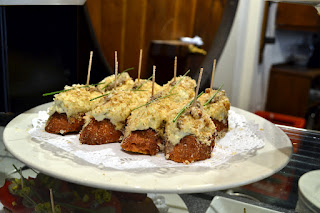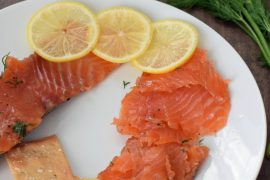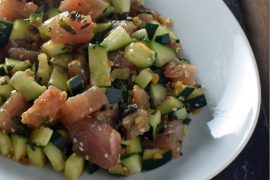 |
| Gambas al Ajillo at Taller de Tapas; Chorizo Sandwiches at Ciudad Condal; Pintxos at Sagardi; Smoked Salmon at Qu Qu |
This is the first part of our eight-part travel series on Northern Spain. Later posts cover the Basque Country and San Sebastian, the mountainous regions of Cantabria and Asturias, and the seaside region of Galicia. We also present a three-part review of the acclaimed Restaurante Arzak in San Sebastian.
Barcelona is a vibrant city with a distinct culture that makes it unlike other places in Spain. It sits at a crossroads of culinary currents, assimilating mainstream Spanish food from the southwest, Basque influence from the northwest, French from the north and its own Catalan culinary tradition from within. Barcelona is the capital city of the region of Catalunia, with its own language (Catalan) and culture. Like other parts of Spain, it offers a cuisine that is distinctly regional, while incorporating broader Spanish concepts and other regional influences.
 |
|
Classic Tortilla with Pa amb Tomàquet
|
Perhaps as much as anything else, Catalans enjoy their pa amb tomàquet (or “pan con tomate” in Castillian Spanish); crusty bread rubbed with garlic and fresh tomato and drizzled with extra virgin olive oil. For all of its simplicity, it is a culinary masterpiece: the crispness of the bread contrasts with the juiciness of the tomato, the bite of the garlic and the fruitiness of the olive oil. It was served to us everywhere, whether as a start to the meal, as an accompaniment to a dish we ordered, or as the base for a sandwich. We never tired of it, and we wondered why we bothered topping our bread with anything else. We have been preparing it for ourselves at home ever since (see our recipe).
Catalan cuisine is out in force in the Eixample district, a modern section of Barcelona with wide boulevards, giant octagonal intersections and elegant buildings and stores. The tree-lined Rambla de Catalunya is overflowing with outdoor eateries, where happy patrons enjoy food and wine at all hours of the day. A few days gave us time to sample several of the fine establishments in this area, but one stood out above the rest.
Ciudad Condal
The casual and bustling Ciudad Condal (“Ciutat Comtal” in Catalan) offers some of the best tapas we had during our time in Spain. It occupies a patch of prime real estate on the Rambla de Catalunya, about a block from Barcelona’s central square, and it knows how to take advantage of the location. Attractive outdoor tables sit under umbrellas on the tree-lined promenade. Inside, a bar showcases colorful tapas and piles of sandwiches amid glasses of the house wine. Dining rooms tunnel into the back of the restaurant and climb upstairs to the second floor. During peak hours, the whole place is packed.
 |
| Tiny Fried Fish |
And for good reason. A meal at Ciudad Condal is a parade of deliciousness, the plates mouthwatering in their simplicity, the portions sized to make you long for more. There were tiny whole fish, heads removed and lightly fried, so small and tender that they could be eaten whole down to the tail, the bones offering nothing more than a delicate crunch. Sweet piquillo peppers arrived stuffed with salt cod and baked with creamy béchamel. Smokey chorizo was offered on platters or stuffed into sandwiches on crusty baguettes. Mondaditos (tiny bites served on toasts) were composed of rich cheeses. Tortilla was classically prepared and served with crisp but juicy pan con tomate. Crema catalana, a classic similar to the French creme brulee topped with torched caramel, was a satisfying dessert.
 |
| Patatas Bravas |
But the best of all was an unassuming plate of patatas bravas. They were simple but perfectly executed; the best single dish of our time in Barcelona. The crisp cubed potatoes were topped haphazardly with the traditional red and white sauces. The red sauce was a smooth, slightly spicy tomato sauce spiked with smokey pimentón. The white was a creamy garlicky aioli that was piped over the top. The appearance was a mess, with no finesse or any attempt at elegance. It was all about the taste. We ordered it twice in three days; once for dinner and again another time for breakfast. In other towns throughout Spain, we searched in vain for its equal.
 |
| The Breakfast Scene at Ciudad Condal |
Ciudad Condal exemplifies the versatility of the Spanish tapas bar, a common sense model that mysteriously has not caught on in the U.S. The fully loaded bar is put to effective use not only in the evening but throughout the day. Breakfast is served at the bar or on the outdoor tables: fresh croissants, montaditos and finger sandwiches are plucked from displays on the bar and served with freshly squeezed orange juice and café con leche, prepared with espresso machines that sit among bottles of wine and liquor. By lunch time, the breakfast pastries at the bar have been replaced by sandwiches and displays of tapas, the staff that prepared our coffee converted into bartenders, dishing out glasses of the house wine for a few bucks each and supplying hungry customers with tapas. In the evening a mob scene awaits tables outside, in the back and upstairs. Separate waiting lists are maintained for outdoor and indoor tables.
Qu Qu
 |
| Asparagus with Brie |
Another fine location in the area is Quasi Queviures, affectionately known as “Qu Qu”. It is well located on the Passeig de Gracia, close to the architect Antoni Gaudi’s eccentric Casa Batlló, with its colorful exterior and chimneys that look like fingers. Arriving late, we found all of the outdoor tables full, so we sat in the comfortable dining room in the back amid a colorful and multilingual array of posters.
Channeling Barcelona’s French influence, Qu Qu makes liberal use of brie. A standout was a simple montadito of brie and black truffle–the cheese was creamy and the toast was buttery and crisp. Asparagus with brie was an equally successful yet lighter snack. On the other hand, crushed potatoes with Catalan sausage (and more brie) was not as successful; I was glad to try Catalan sausage but it was one-note and too large a portion to finish. A more enjoyable dish, without brie, was a crunchy-chewy bread topped with smoked salmon, avocado puree and creamy white cheese; Qu Qu’s answer to lox and bagels. It was attractively presented with a pile of fresh arugula creating a colorful composition of pink smoked salmon, white cheese, light green avocado, dark green arugula and golden crispy bread.
La Rita
 |
| Tomato Soup with Basil Sorbet |
A few blocks away, La Rita offers an excellent sit-down meal. It is an elegant place, with white table cloths, fine glassware and two separate dining rooms. On a weekday lunch, the crowd included families but also plenty of business lunches, including customers in suits contently enjoying a meal alone with a glass of wine and a loaner newspaper. Amid all the elegance, La Rita remains casual and offers a three-course set menu for less than 10 euros. There was a line to get in at lunch, but with two people we only waited a few minutes.
Our lunch began with a chilled tomato and bread soup with basil sorbet. It was cool and refreshing on a hot day, similar to a smooth gazpacho in appearance but with a stronger tomato and olive oil flavor. The basil sorbet was fresh and herbaceous, with a touch of sweetness. Crunchy bread added nice texture contrast. We devoured it.
 |
| Fideuà |
Cod fillet “gratinado” with pimientos de padron was less successful. Our American palates generally had trouble with fresh cod in this region of Spain, which was firmer and fishier than we were used to. The flavors of peppers and fish complimented each other well, however.
A more successful entree was the fideuà, a traditional dish that is similar to paella but with short, thin noodles (“fideos”) instead of rice. Our fideuà came topped with a single large shrimp and three small clams and was filled with chopped cuttlefish. It had a richer and meatier flavor than I expected, the color a rich brown rather than the yellowish/reddish color typically associated with paella. The fideos themselves were crisp on top and soupy underneath, a nice contrast. The shrimp was unfortunately overcooked, but the clams and cuttlefish done perfectly. It was served with a fantastic garlic aioli that melted into the sauce.
The Barri Gòtic is Barcelona’s old town, with narrow cobblestone streets and old fashioned charm. Highlights include Barcelona’s massive cathedral and the world-class Museu Picasso, showcasing many of the artist’s early works. Picasso and I share an obsession with Diego Velasquez and his masterpiece, Las Meninas (Picasso’s thoughts on the subject being of somewhat greater significance), and the artist’s playful riffs on the classic are on full display. If Picasso were around today, I am confident he would also share my affection for the culinary offerings available nearby on the Carrer de l’Argenteria.
Sagardi
 |
| Pintxos at Sagardi |
Sagardi, a Basque restaurant with four locations in Barcelona, was our first foray into the art of pintxos and a preview of the Basque leg of our trip. Pintxos are bite-sized snacks, sometimes simple and sometimes intricate, that are usually served on little toasts and speared through with a toothpick. Traditionally, pintxos bars are self-service; you grab a plate and go to town, grabbing whatever looks good to you in the moment.
It all looked good to me. Sagardi is a feast for the eyes and the taste buds. Creamy crab salad was perched on crisp toasts and sandwiched between halves of a mini croissant. Mild creamy cheese was topped with fruit jam and crushed nuts for texture. Olive oil cured tuna was piled on sweet pimientos de padron and topped with a tangle of crispy onions. Once in a while a gentleman behind the bar would announce something like: “¡Croquetas de setas!” And a plate of toasts with mushroom croquettes would be placed at the bar. “¡Salmon ahumado!” Smoked salmon appeared on toasts with mild onion relish. Turning in our five toothpicks, we were charged 9 euros. We would have liked to have explanations for some of the pintxos we could not identify, but it was adventurous without. If you asked persistently, the guy behind the bar would gruffly describe a single item and then go back to towel drying plates for the next round of customers.
Taller de Tapas
 |
| Shrimp and Avocado Salad |
Across from Sagardi and spilling into the square, the “tapas workshop” sells modern and inventive tapas rooted in tradition. It is pricier than Sagardi but it offers outdoor seating, with classy black and white chairs situated under white square umbrellas.
Tortilla at Taller de Tapas was thinner and softer than usual, closer to an American omelet, filled with wild garlic and earthy wild mushrooms, a very nice combination. Garlic reappeared in the classic gambas al ajillo, served sizzling hot in a cast iron casserole. The shrimp were delicate and the garlic cloves were mildly roasted, although I would’ve liked a stronger flavor and more heat. A refreshing and more modern dish was a salad of avocado and chilled jumbo shrimp with basil vinaigrette, served with a pile of fresh greens. I enjoyed stacking this treat up on the crusty pan con tomate. A cold beer rounded out a satisfying lunch on the square.
View Foods of Barcelona in a larger map
Ciudad Condal: Rambla de Catalunya, 18, 08007 Barcelona. +34 93 318 19 97.
Quasi Queviures (“Qu Qu”): Passeig de Gracia, 24, 08007 Barcelona. +34 93 317 45 12.
La Rita: C/ Aragón, 279, 08007 Barcelona. +34 93 487 23 76.
http://www.laritarestaurant.com/
Sagardi: C/ Argenteria, 62, 08003 Barcelona. +34 93 319 99 93.
http://www.sagardi.com/
Taller de Tapas: C/ Argenteria 51, 08003 Barcelona. +34 93 268 85 59.
http://www.tallerdetapas.com/
Visit Spain and Make Tapas:



